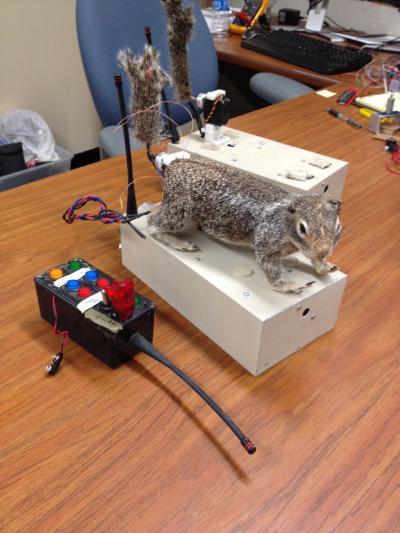But actual squirrels don't like being used in studies about rattlesnakes so Sanjay Joshi, professor of mechanical and aerospace engineering at U.C. Davis, has built "robosquirrels" that can help biology understand what is going on. The latest research centers on two squirrel behaviors in reaction to rattlesnakes: a tail flagging movement and the warming of the tail. When adult squirrels detect a snake, they approach it head-first in an elongated posture, making flagging movements with their tails. They also seem to heat their tails.
Because rattlesnakes can "see" in the infrared, the researchers thought the squirrels might be sending a signal to the snakes. But, with live squirrels, there is no way to separate tail flagging from tail heating. Enter the robots. Joshi's engineering lab built a squirrel with a heatable tail and a tail flagging mechanism, each controlled separately.
Using the robosquirrel, Aaron Rundus, now an assistant professor at West Chester University in Pennsylvania, showed that the snakes responded to the heat signal from the squirrel.

Robosquirrel. Credit: Andy Fell, UC Davis
"It was the first example of infrared communication in the animal world," Joshi said. That work was published in 2008. Fieldwork is more challenging, he said. Ryan Johnson-Masters, a graduate student now at the Sandia National Laboratory in Livermore, built a new robot with smaller and more robust controls that was easier to transport into the field. The field season is fairly short, a few weeks in late spring and early summer when squirrel pups are born and rattlesnakes come hunting for them.
Then you need to find rattlesnakes in rough country.
Rulon Clark, assistant professor of biology at San Diego State University, began collaborating with Joshi and psychology professor Donald Owings in 2007. Together, they wrote a grant proposal to the National Science Foundation to take the robosquirrel into the field, which was funded with $390,000 in 2010.
Once the researchers have located a foraging snake, they put down some track, set up the robosquirrel and a video camera to record the scene and retreat behind a blind. The snakes seem to accept the robosquirrel as real, Clark said. One of their videos shows a snake biting the robot's head.
Snakes will rarely strike at a flagging adult squirrel -- and if they do they almost always miss, Clark said.
"Squirrels have a remarkable ability to move out of the way of an oncoming snake strike," he said. Even adult squirrels that do not seem to be aware of a snake will often successfully dodge a strike.
Squirrel pups are much more vulnerable. They have less resistance to snake venom and seem more reckless in their behavior. They show the same displaying behavior as adults, but will get closer to snakes -- sometimes with fatal results.
Although not much is known about the mental abilities of rattlesnakes -- they are not ideal lab animals, after all -- they do behave in the field as if they are making complicated assessments about foraging behavior, Clark said. For example, they react differently to adult squirrels versus pups.
Why do squirrels approach the snakes at all? Clark says that they may be trying to assess the nature of the threat. Sometimes snakes will leave the area after encounters with squirrels.
Before joining the campus in 2001, Joshi worked at NASA's Jet Propulsion Laboratory on robots for space exploration. At UC Davis, Joshi began working with psychology professors including Owings and Jeffrey Schank. With Schank, he built robots that emulated the behavior of young rat pups -- revealing new insights into both rat behavior and robot design.
"The reason I'm so excited is that with robots we can really change how animal behavior studies are done," Joshi said.




Comments